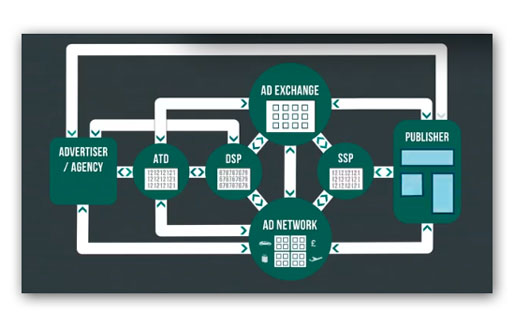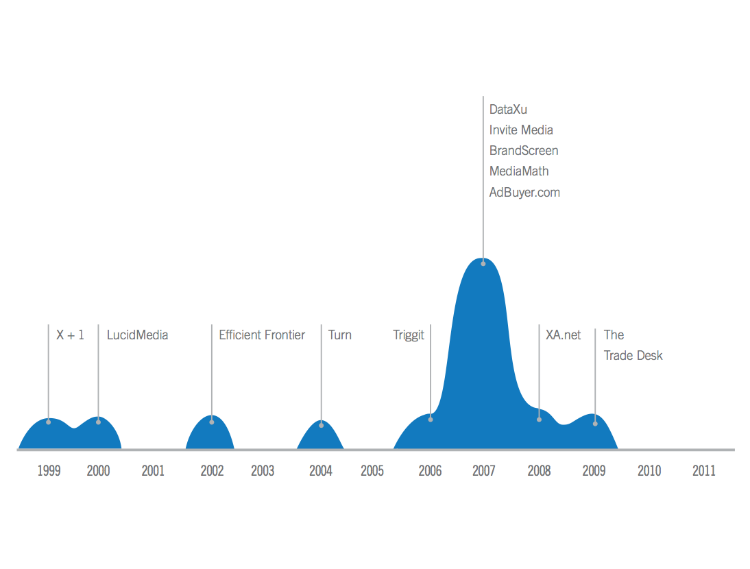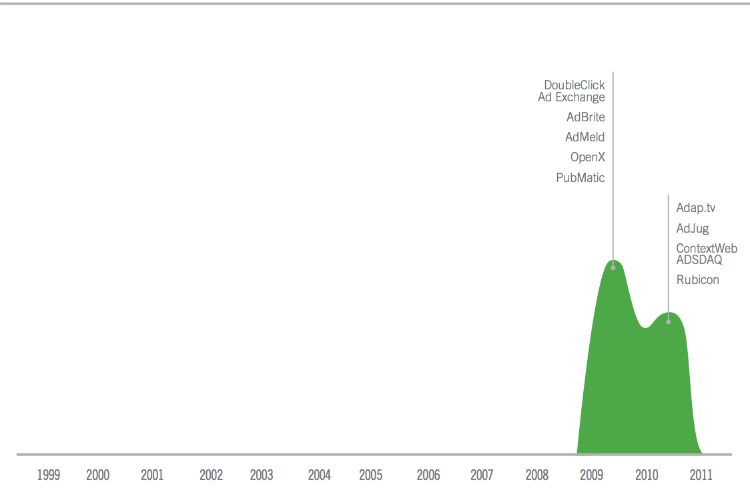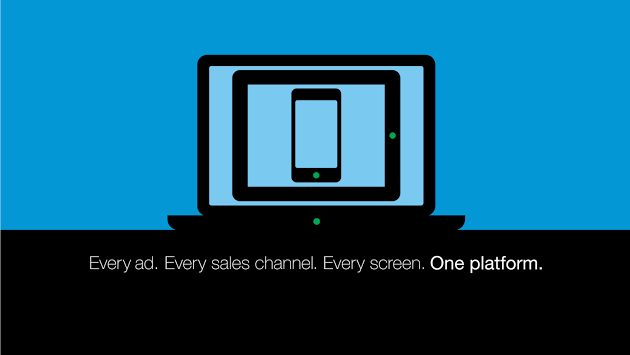History of the RTB market: stages of development and the emergence of major players

The technology of selling advertising through real-time auction (Real-time Bidding - RTB) appeared when a critical mass of data was available for analysis by automatic systems that select sites for advertising and, on the other hand, the amount of advertising available online space "(hereinafter we will use the term" advertising equipment ").
Today, various data providers allow advertisers to more effectively place their advertisements, and the huge amount of available advertising inventory allows you to buy impressions of the most relevant audience. The overall liquidity of the online advertising market has never been so high - a small startup and the largest agency leading the Fortune 500 client can find a profitable placement option.
')
At the same time, the advertiser, knowing what kind of audience he wants to show his advertisements (for example, banners), with a huge number of available advertising sites cannot independently determine which of these sites really contains the people needed for business. In order to conduct even a small campaign, the advertiser would have to negotiate with at least several sites, determine the cost of placement and monitor its effectiveness. Even setting up identical targing at different sites is no easy task.
RTB technology helped advertisers to find the best advertising offers using one entry point - special programs get data from various sites and connected advertising networks, analyze audience behavior and buy shows for the most targeted people.
However, the market did not immediately come to this configuration of the system.
Advertising exchanges
Initially, advertising exchanges brought more liquidity to the market - selling and buying advertising has become a bit easier. However, in 2007 there was a significant change: it was then that the largest IT companies bought the three largest advertising exchanges. In April 2007, Yahoo acquired Right Media, in May DoubleClick was taken over by search giant Google, and in August Microsoft bought AdECN. These deals opened up to many advertisers access to large amounts of advertising inventory, which allowed the display advertising market to make a leap in its development.
Consolidated Procurement Systems
The advertising market has become even more highly liquid, however, advertisers could not take advantage of this for the reason described above, the difficulty of working with various sites and networks. This inefficiency had to be eliminated, and it was this that was facilitated by the emergence of new market players. Such companies could get access to advertising inventory sold on various advertising exchanges, and all this in automatic mode, without the need to independently establish relationships with sites (like publishers). Among these new players were systems representing the interests of advertisers (Demand-side Platforms - DSP) - they only met the needs of the party that buys ads, that is, advertisers and agencies.
According to a Google report, 2007 also became the heyday of DSP - the five largest companies to date were founded just then. Among them was Google Media bought in 2010 by Invite Media.

The founding dates of major players in the advertising market, who are now working as a DSP
DSPs are not the only players who have saddled the wave of availability of large amounts of advertising equipment.
In addition, there were startups that worked in niches at the intersection of data and inventory liquidity - for example, some of them were engaged in the development of retargeting technologies.
At the same time, advertising networks began to look closely at DSP as a means of distributing their own advertising equipment - no one wanted, despite the general growth of the advertising market, to receive less income, because suddenly someone had not bought up all the advertising areas of the site.
This led to the emergence of “DSP for Publishers” - systems operating on the side of advertising sellers or SSP (Supply Side Platforms). SSP helps sites sell their advertising inventory at the maximum price automatically. Both SSP and DSP use similar technologies to work. Thanks to SSP, a site can be connected to different ad networks, thus obtaining one entry point for many advertisers.

Despite the emergence of new market players, the purchase of advertising on various exchanges was a costly and inefficient process - each site had its own access interface, which alone made it impossible to quickly “tweak” the campaign setting to buy ads on different exchanges to avoid to the same target user through different channels - and in this case one person was charged twice.
Things were not very good with general analytics throughout the campaign. Definitely needed a solution that will allow you to buy advertising in automatic mode on different exchanges and networks. Similarly, publishers experienced problems when working with clients - they had to spend resources on communication and reaching agreements with each advertiser. Popular at that time, the method of selecting the most effective advertising network was the usual A / B testing, which took a lot of time and required a large amount of resources.
And this is where RTB technology appeared.
RTB efficiency
With a large number of advertisers and high liquidity of the online advertising market, only the latest innovation was lacking. That is what RTB technology has become.
Thanks to this invention, unprecedented opportunities have opened up when display advertising is being placed. The potential was discerned by all the major advertising exchanges and networks that have begun to actively develop the API for working with RTB.
As it turned out, the market was just waiting for such a decision, which could improve the efficiency of work, therefore, the further growth in the use of RTB was explosive.

The time of the announcement of support for RTB by the largest advertising networks and exchanges. Chart Source: Google Report
The whole process of the evolution of the market described above is well traced by the specific examples of some of the largest players working with RTB.
PubMatic
PubMatic's leading SSP platform, which, according to rumors, plans to hold an IPO when evaluating a business of $ 1 billion. Pubmatic introduced several innovative solutions that nobody used in the industry before. PubMatic users can work with more than 400 advertising networks, exchanges and DSP.

The Pubmatic ad server is located between online publishers and ad networks, such as Google AdSense, the Yahoo Publisher Network and Value Click. The service helps publishers manage their inventory and increase the efficiency of its use - this is due to the possibility of simultaneous work with various advertising networks, which allows us to find the best option for placement (banner appearance + advertising price).
Clients of the company get access to the analytics panel, which contains a large amount of information that helps manage placements and change the settings of advertising campaigns.
Currently, PubMatic is working with leading publishers and brands of the premium segment. The company's technologies are used to organize RTB and closed auctions (PMP - Private Marketplace). Among other things, PubMatic also supports the sale of mobile advertising equipment - the mobile direction is becoming increasingly popular.
Rubicon project
Even more clearly, trends in the development of online advertising can be traced to the story of another leading market player - the Rubicon Project. The Los Angeles-based advertising technology company was founded in 2007 by Frank Addante, Craig Roa, Duke Chau and Julie Mattern - they were previously colleagues in the L90 advertising network.
Initially, the core technology of Rubicon was A / B testing of ad networks and banner formats. At this stage in 2009, the company was able to attract $ 33 million of investments from several well-known venture capital firms. At the same time, OthersOnline was acquired , whose strength was the technology for compiling network user profiles. The main users of the OthersOnline service were publishers.
The purpose of the purchase from Rubicon was to obtain the possibility of “combining disparate information received from various data providers and creating a unified and complete presentation of the audience that would be of interest to publishers, advertising networks and advertising exchanges”.
In May 2010, a new takeover took place - this time Rubicon acquired information security startup Site Scout. The main goal is to use Site Scout technologies to implement a solution that would allow publishers to avoid placing malvertising on their resources. In October of the same year, the purchase of the popular advertising network Fox Audience Network, which had unique display advertising technologies, was made.
The Rubicon project was called the industry leader RTB in the Forrester report . According to analysts, one of the main advantages of the service is the support of private advertising systems and advanced functionality of programmatic sales. In 2012, to enter the mobile advertising market, Rubicon bought an advertising startup Mobsmith. The goal of the takeover is to create a “unified platform and platform for the sale and purchase of both display and mobile advertising equipment”
At the moment, the main direction of Rubicon's business, which brings tens of millions of dollars of income, is holding closed RTB-auctions for publishers of the premium segment.
Google DoubleClick Ad Exchange (Admeld)
In 2011, SSP under the name Admeld was bought by Google for $ 400 million. The mere fact that the search giant has laid out such money for an advertising platform suggests that technologies related to RTB have a certain future. Admeld is now part of the DoubleClick Ad Exchange ad exchange, so for many publishers, using this platform is a good solution.
Google’s network performance has increased dramatically since the introduction of support for RTB technology. Sales of advertising equipment through RTB increased from 8% in January 2010 to 68% in May 2011 - an increase of 60% in just one and a half years.

Chart Source: Google Report
The DoubleClick Ad Exchange platform allows publishers to work with various ad networks and exchanges, and also provides them with an interface for managing and editing placements. Among the clients of the platform are such famous publishers as Discovery, FOX News, Huffington Post, IAC, Thomson Reuters and WWE, who use ex-Admeld to manage the placement of advertising banners on their resources.
One of the advantages of the platform is that it "knows" how to identify advertising equipment, which sells worse and replaces it with more efficient tools. This allows you to increase the ROI of campaigns, which publishers really like.
findings
The considered stages of development of the advertising market clearly demonstrate a tendency to increase its effectiveness. The experience of leading foreign players suggests that instead of A / B testing of the effectiveness of working with one or another advertising network, publishers are much more profitable to use the systems with the help of which it is possible to organize an auction for advertising, and it does not matter which network it will eventually happen . In turn, it is easier for advertisers to use one point to buy advertising in automatic mode at different sites. That is why DSP and SSP appeared.
The overall success of RTB, which has become a crown of the online advertising market, is simply explained - buyers saw the real effect of using this technology. Even according to the Google DoubleClick Ad Exchange for 2011, conducting advertising campaigns via RTB allowed advertisers to save 19% of their money on CPM compared to placements made using other mechanisms.
On the Runet market, the development of online advertising technologies is going through the same stages as in the West. Industry players (including our AdvertOne company) started with A / B testing of the effectiveness of advertising sites and placements, but now it is becoming increasingly clear that the list of tools used for advertising needs to be expanded, including modern technologies such as RTB .
The history of the advertising market itself tells us that RTB technology is not a passing trend of fashion, but a serious tool that will be used for many years.
Source: https://habr.com/ru/post/225221/
All Articles